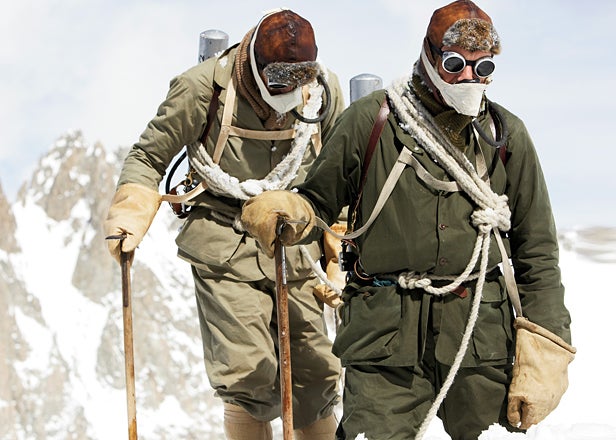IT'S ONE THING to speculate about whether George Mallory and Sandy Irvine reached the summit of Mount Everest in 1924, a generation before Hillary and Norgay's success in 1953; it's quite another to put on hobnail boots and try to knock the bastard off yourself. But that's just what American Conrad Anker, 47, and Briton Leo Houlding, 30, did for the new film The Wildest Dream, which hits screensÔÇöincluding ImaxÔÇönationwide on August 6. Part Ken BurnsÔÇôstyle history, part adventure mystery, the movie, narrated by Liam Neeson, with voice-overs by Ralph Fiennes and the late Natasha Richardson, reconstructs Mallory's quest through archival footage and personal correspondence. At the heart of the project is an attempt by Anker and Houlding to reenact the climb with period gearÔÇögabardine jackets, hobnails, and leather-strapped goggles they don for a portion of the ascent.
The climbers come from the Tibetan (Chinese) side, and the crux of the drama happens at the Second Step, a 15-foot 5.9 cliff with 10,000 feet of exposure that modern alpinists scale with the aid of a ladder. Mallory would have had to free-climb it, using his bare hands. By the time they reach the Second Step, Anker and Houlding have already upgraded to modern expedition-wear to ward off frostbite, but they still have a hypothesis to test. Anker removes the ladder and attempts a free climb of the Step. He makes only one move and then slips and falls, caught by Houlding's belay and a camming device he'd placed.
“I was pretty shocked when he fell off,” Houlding says. “He had modern climbing equipment for protection. If he had slipped like that in 1924, he almost certainly would have taken a ride.” In the end, Anker makes it over the top, as a Chinese climber did in 1960, on the first ascent from the Tibetan side.
So did Mallory make it over the Step? The film's director, Anthony Geffen, is careful to leave the question open-ended, but the facts quickly stack up against the British national hero. Mallory had climbed up to 5.9ÔÇöabout the technical difficulty of the Second StepÔÇöbut that was in the Alps. Above 28,000 feet, still wearing hobnail boots? “It's possible but unlikely they climbed the Second Step,” says Anker.
But that's almost beside the point. Just reaching it with the gear and know-how of the 1920s would have been an incredible accomplishment. “Everest at that time was another planet,” says Geffen. “They were out of their deck.” As it happened, Geffen's crew was also at its limits. Altitude sickness disabled the entire camera crew. In the end, two unaffiliated guides shot the movie's high-altitude scenes.
All the same, the doubtful conclusion and technical difficulties don't ruin the film. The Wildest Dream offers the most authentic portrayal yet of the boldness of Mallory and Irvine's adventure. Nobody before them knew where to begin the route or how extreme altitude would affect humans. Nobody had been to Everest's Death Zone, and the Brits became its first victims.


